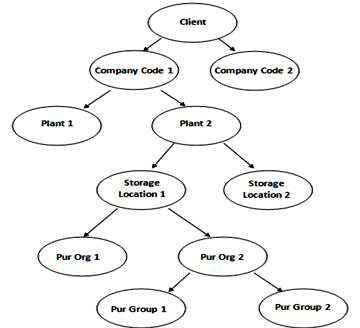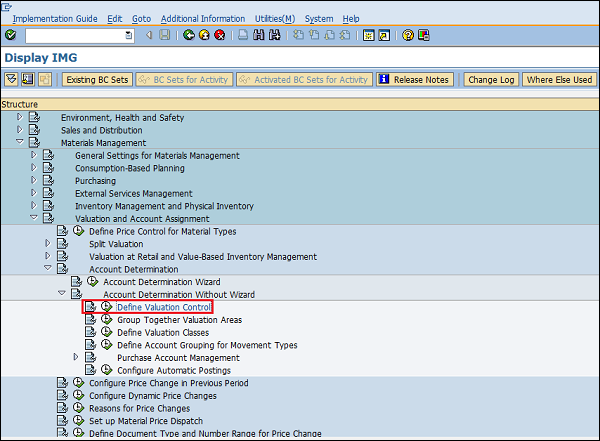An enterprise structure defines various levels in an organization. These levels are placed according to some hierarchy. Each level has some specific functionality associated with it, which in a combined way describes the working of an organization. In addition, an enterprise structure defines various organizational units that are present in an enterprise. The organizational structure in MM consists of the following organizational levels −
- Client
- Company Code
- Plant
- Storage Location
- Purchasing Organization
- Purchasing Group
The following diagram depicts one such organizational structure that describes the levels incorporated in an organization. It puts the client at the topmost, followed by multiple company code, followed by multiple plants, plants having multiple storage location with their own or centralized purchasing organizations.

Client
A client has the following attributes −
Client is a commercial organizational unit in R/3 system.
It has its own set of master data with independent table sets.
According to hierarchy, a client occupies the highest level in a SAP system.
Data that is maintained at the client level is valid for all organizational levels.
Company Code
A company code has the following attributes −
Within client, a company code is an independent accounting unit.
It is a legal entity that has its own profit, loss and balance statement.
It is the smallest unit in an organization for which a complete independent account set can be replicated.
Plant
The basic points to be noted about a plant are as follows −
Plant is an organizational unit within a company where activities take place. A plant will produce goods and make goods available for the company.
It is a unit having manufacturing facility, warehouse distribution center, or a
regional sales office within logistic. It subdivides an enterprise in different aspects.
Storage location is an organizational unit, which actually differentiates between different material stocks in a plant.
Storage location is a place where stock is kept physically.
A plant can consist of multiple storage locations. All data is stored at storage location level for a particular storage location.
Purchasing Organization
The points to be noted about a Purchasing Organization are as follows −
A purchasing organization is an organizational unit under a company or a plant that is responsible for the procurement activities according to requirements. It is responsible for external procurement.
A purchasing organization can be at the client level, which is known as a centralized purchasing organization.
A purchasing organization can also be at the company or plant level, which is known as company-specific or plant-specific purchasing organization.
Different forms of purchasing can be described as follows −
Centralized Purchasing
Purchasing organization is not assigned to any company code. It procures for all company codes belonging to different client.
Company Specific Purchasing
Purchasing organization is assigned to a company code only. The plant belonging to the company code can purchase through this purchasing organization.
Plant Specific Purchasing
Purchasing organization is assigned to a plant. Only this specific plant can purchase through this purchasing organization.
Purchasing Group
The attributes of a purchasing group are as follows −
Purchasing group is an organizational unit responsible for the everyday procurement activities within an organization.
It is a buyer or a group of buyers responsible for the procurement activities in a purchasing organization.
Storage Location
A storage location has the following attributes −


No comments:
Post a Comment